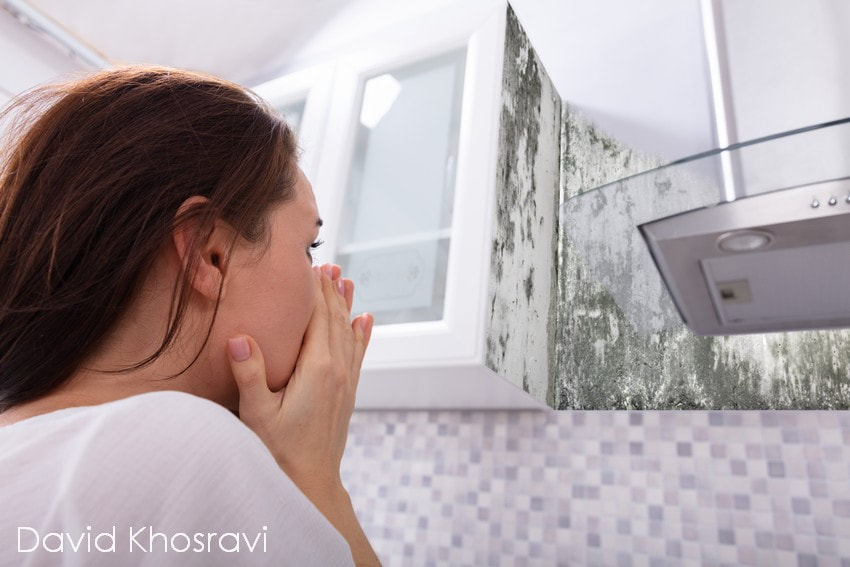|
What are moulds? Moulds are microscopic organisms that play a vital role in digesting organic matter. In nature, as long as there are organic matter and humidity, you expect to see mould. Moulds are fungi with thousands of species. The presence of moulds is unavoidable; however, the problem arises for us humans when they appear in our homes to the extent that may cause health issue and property damage. Moulds reproduce through spores; spores are airborne and can land anywhere. If the conditions are right at home (moisture levels of over 60%), spores will grow into a new colony. Where does mould grow? Some of the home areas are more prone to collect moisture like Attics, Crawl Spaces, Basements and Showers (bathrooms). Water leaks can happen at any part of the house, and if not discovered or dried quickly, it may also cause mould growth. Any surface with organic content can support mould growth, such as wood, ceiling tiles, wallpaper, paints, carpet, sheetrock (drywall), and insulation. The truth is mould (or spore) is everywhere, and it is beyond our ability to keep our home fully mould free. You'll know you have a problem if you have a mould growth of ten inches or more in an area. However, you can control mould growth by keeping your home dry. You'll be exposed to mould, to be specific spores, when mould is physically disturbed, and that is when spores became airborne. You can also be exposed by touching items and eating foods that are contaminated with mould. Do moulds affect my health? It depends on the mould type and the extent of exposure; however, most moulds seem to be harmless to healthy people. But, infants, seniors, pregnant women seem to be vulnerable to the effects of mould. Also, people with pre-existing health conditions like having allergies, asthma, immune suppression, lung disease are at high risk. Some species of mould produce toxins called mycotoxins. High levels of exposure to mycotoxins may cause fatigue, nausea, headaches, and irritation to the lungs and eyes. Note. Mould is a recognized health issue. Many published discoveries by organizations like the Institute of Medicine (IOM) and the Centers for Disease Control and Prevention (CDC) have been linked to mould toxic substances to different health conditions. What are the ways to limit mould growth in my home? Prevention is a better strategy since mould removal is dangerous and expensive. Here are the keywords you should have in mind, water, humidity, air circulation. The list below is some of the preventative steps you may consider.
How do you know if you have a mould problem? In the industry, these are some of the methods used to detect moulds: visual inspection, air sampling, surface sampling, and borescope - A borescope is an optical instrument designed to assist visual inspection of difficult-to-reach cavities. If it is necessary, laboratory testing can identify the species of mould present in your home. The quickest and the primary methods are visual and odour detections. Growing mould digests organic matter, releasing gas (also referred to as out-gassing). You may have noticed a musty odour from a wet, stuffy basement or laundry room; this musty smell is a good indication that there is a mould issue. You do not necessarily have to see the mould since mould can hide behind walls where moisture is present; this is referred to as hidden mould. If the temperature drops in the winter months, mould will go dormant, and smell may subside. But, as the temperature rises, mould growth will begin again, resulting in a more pungent odour. If the musty odour persists and the area feels humid, and you cannot visually see the mould, you may contact the professionals to inspect your house. If not hidden, mould growth can be identified by the discolouration of the surface. Such discolourations may appear as spots of black, brown, green, purple. Note that the mould penetrates the organic matter, and it is embedded inside; scrubbing the surface will not remove the mould. I not sure, and I am concerned about my health. Is there a test I can do? Do-it-yourself test kits are available for mould testing, typically a dish that is used for capturing spores. However, there are opposing opinions on the accuracy of do-it-yourself kits in the industry. Mould removal and inspection companies use sophisticated equipment for such testing. To say the obvious, you can assume that a professional approach should provide more reliable results. Typically multiple indoor and one outdoor sample counts are measured—the outdoor sample count can be used as a background or baseline sample. You have found mould in your house, what is next? Identify the source of moisture and the high humidity level; if necessary, hire a professional to help you. Eliminate the source and investigate the extent of the problem. Mould clean up is a complex process; you may try to do it yourself if the area is only a few square feet. Otherwise, it is recommended to hire a professional. Note. Sampling for the type of mould is not recommended. If you have identified the mould by its musty smell or visual inspection, a potential health risk exist, and it must be removed. The professional mould removal companies will confirm your observation and remove the mould without contaminating other areas in the house. The safe removal of mould is vital in the process. Another crucial work these companies will do for you is to make sure mould will not return; they'll advise you on controlling the source and being vigilant to avoid the mould's future return. Note. You may get in touch with your home insurance company. Some policies cover mould inspection and removal. How do I choose a mould removal company I can trust? Here is a list of questions you should consider asking the company:
AuthorThe above Real Estate article was provided by David Khosravi, a leader in his field in Willowdale, North York, Toronto. Reach out to David via email: [email protected] or by phone: 416.990.2424 Comments are closed.
|
Categories
All
AuthorDavid Khosravi |


